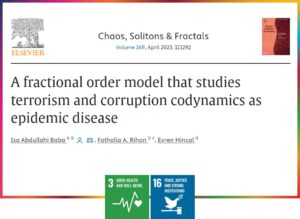
In a notable study co-authored by a researcher from Near East University, a unique fractional order mathematical model has been developed to analyze the coexistence and dynamics of terrorism and corruption, drawing parallels with epidemic diseases. This innovative approach aligns with the Sustainable Development Goals focused on ensuring healthy lives and promoting peace, justice, and strong institutions.
The study employs a fractional order model to understand how terrorism and corruption simultaneously affect communities, particularly in developing economies. The research goes beyond traditional analyses by not only establishing the existence, uniqueness, and stability of the model’s solutions but also by conducting numerical simulations to validate the analytical results. This method offers a deeper insight into the complex interaction between terrorism and corruption over a two-year period.
Key findings from the study reveal that both terrorism and corruption transmission rates significantly impact the growth of these detrimental populations. Interestingly, the study observes a decrease in the combined population of terrorists and corrupt individuals over time, attributed to a shift in individuals’ inclinations towards one criminal act over the other, driven by various factors like personal benefits or loss of interest.
The study strongly recommends that stakeholders focus on reducing both terrorism and corruption transmission rates and enhance recovery rates from these social maladies. It calls for governments to enforce anti-terrorism and anti-corruption laws more rigorously and to sever the links between these two interrelated issues. Community unity and awareness are also emphasized as crucial in identifying and addressing the root causes of terrorism and corruption.
Furthermore, the research underlines the importance of international collaboration and local authorities working together to better understand and monitor these challenges. Roundtable discussions, inclusive of government representatives, civil society, embassies, and international organizations, are suggested for planning and implementing strategies to combat these issues effectively. The study also highlights the need for further research, including agent-based modeling, to understand individual behaviors and the most impactful parameters in addressing the dual threats of terrorism and corruption.
In summary, this research from Near East University offers a groundbreaking perspective on tackling terrorism and corruption, providing a quantitative and analytical framework that can significantly contribute to achieving a healthier and more just global society.
For further details, access the original paper from the publisher’s link:
https://www.sciencedirect.com/science/article/pii/S0960077923001935